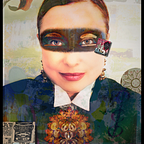The Materiality of Suffering
During one of the worst periods of my life, I turned toward painting and writing without strategy, knowledge, skill or talent. Creating was an impulse. I converted my garage into a studio after painting one large painting. I built myself a sanctuary — a place to practice, get messy and turn inward. Building a studio without being an “artist” became one of the most important, life giving gifts I ever gave myself. I didn’t know that a year later I would be in the midst of constant grief as I lost my nephew, my mother, brother, brother-in-law and had to put down my dog on the anniversary of my mother’s death. These losses were compounded by other losses and struggles that made life seem truly impossible, all of this happened in the midst of isolation in a global pandemic. Creating kept me on my feet, helped me focus, connect to the outside world and breathe.
When you experience a storm of tragedy and survive, people imagine you will emerge like a wizened prophet with secret knowledge. Surely there must be some reward for such a magnitude of suffering. The truth is that life is relentless and demands that you put gas in your car and pay the mortgage. Gut wrenching, blood draining, life-altering suffering doesn’t actually kill you, which can feel like the cruelest part of all.
I knew nothing about creativity and the brain. I knew very little about how creativity supports mental health. I just knew I had to make things. I needed it like sleep and water. I needed to put paint on canvas, dig in the dirt and write poems on scraps of paper. My suffering had a materiality like paint or clay.
A year after my mother died in my living room surrounded by her children and grandchildren, I held my first “art show” in my home. I called it NOTHING WASTED and this poem expressed the work that appeared in the show.
I filled my wounds with dirt from the garden
and dressed them with heavy paint
Applied in brutally bold colors on a sanitary white canvas
Words were good too
I placed them in gaping holes
I ate them like medicine
I wrapped them around me like an ancient blanket
Healing didn’t find me in a reclined position
on a chaise lounge
Healing was located in the garden
where I got close to the ground to remove weeds
amend
and plant
My wounds were knitted together
with sentences waiting to be read
or written
And paint that I applied
with my fingers
Because I could not bear
the distance a brush would create
between me and all of that white space
And miles of walking
Going nowhere in particular
All of it together
was necessary
Wounds are tender
They take time
Be patient
Give them lots of air
and light
and words
and paint
and dirt
I wrote lots of poems, made lots of art and didn’t judge whether it was good or bad. I posted a lot of it on social media and strangers said kind things and shared their own pain. That made my aloneness and heart break more bearable. Art kept me on this planet when I was sure my knees would buckle and I couldn’t catch my breath. I was no sage or prophet, but I learned how to transmute my pain into art, some of which now hangs on living room walls.
Creativity helped me heal, made me a better problem solver in my business and gave me somewhere to go when the only other place to go was vantablack.
We think that creativity is the domain of children and the talented, but it belongs to all of us. It’s our birthright as humans. We dance, make music, paint, write, sculpt and find ways to make the world more beautiful. And that makes life more bearable.
You can follow Ann marie’s art, style, garden parties and life journey on Instagram at trailsnotpaths and her website annmariehoughtailing.com
